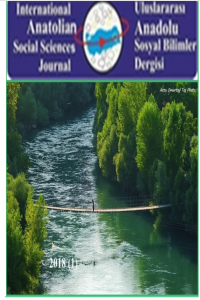TARAFTAR MARŞLARININ SEMİYOTİK ANALİZ YÖNTEMİYLE İNCELENMESİ: TRABZONSPOR FUTBOL KULÜBÜ ÖRNEĞİ
Taraftar, Semiyotik, Trabzonspor, Futbol MArşları
ANALYSIS OF FAN ANTHEMS THROUGH SEMIOTIC ANALYSIS METHOD: THE CASE OF TRABZONSPOR FOOTBALL CLUB
Fans, Semiotics, Trabzonspor, Futbol anthems,
___
- Akerson, F. E. (2005). Göstergebilime Giriş. İstanbul: Multilingual.
- Armstrong, G. (1998). Football Hooligans: Knowing the Score. Berg Publisher Ltd.
- Armstrong, G. and Young, M. (1999). Fanatical Football Chants: Creating and Controlling the Carnival". Culture, Sport Society. 2 (3): 173-211.
- Barthes, R. (2009). Göstergebilimsel Serüven. İstanbul: Yapı Kredi Yayınları.
- Berger, A. A. (1993). Kitle İletişiminde Çözümleme Yöntemleri. Eskişehir: Anadolu Üniversitesi Basımevi.
- Bry, J. And Holt, A.M. (2006). A Historical Overview of Sports and Media in the United States. in Handbook of Sports and Media ed. Arthur A. Raney and Jennings Bryant, Routledge Handbooks Online.
- Caudwell, J. (2011). ‘Does Your Boyfriend Know You’re Here?’ The Spatiality of Homophobia in Men’s Football Culture in the UK. Leisure Studies, 30 (2): 123-138.
- Charlotte E.C.M. (1999). The Semiotic Paradigm: Implications for Tourism Research. Tourism Management,20: 47-57.
- Collinson, I. (2009). Singing Songs, Making Places, Creating Selves: Football Songs & Fan Identity at Sydney FC. Transforming Culturese Journal, 4(1).
- Constantin, P.N. (2015). War and Peace in the Romanian Football: The Historical Evolution of Sport Metaphors. Romanian Cultural History Review Supplement of Brukenthal. Acta Musei, 901-907.
- Fiske, J. (1996). İletişim Çalışmalarına Giriş. Ankara: Bilim ve Sanat Yayınları.
- Gaffney, C. and Bale, J. (2004). Sensing the Stadium. In P. Vertinsky & J. Bale (Eds.), Sites of Sport: Space, Place, Experience (pp. 25-37). London: Routledge.
- Guiraud, P. (1994). Göstergebilim. Ankara: İmge kitabevi.
- Kurtipek, S., Çelik, O.B., Yılmaz, B. ve Yenel, İ.F. (2016). Determination of the Thoughts of National Team Athletes on the Concept of Doping: A Study of Metaphor Analysis. Niğde University Journal of Physical Education and Sport Sciences, 10(2), 318-327.
- Nur, İ.H. (2013). Mesnevi’de Hayvan Karakterleri (Metaforları)[Animal Characters in Masnavi (Metaphors)]. AVKAE Dergisi, 3 (1): 18-30.
- Offstein, E. H. And Neck, C.P. (2003). From "Acting The Test" To" Touching Base": The Sports Metaphor In The Classroom. Business Communication Quarterly, 66(4), 23-35.
- Russell, G.W. (2008). Aggression in the Sports World: A Social Psychological Perspective. Oxford University Press. Saussure, F. (1998). Genel Dilbilim Dersleri. İstanbul: Multilingual.
- Schoonderwoerd, P. (2011). ‘Shall We Sing a Song for You?’: Mediation, Migration and Identity in Football Chants and Fandom. Soccer &Society, 12 (1): 120-141.
- Segrave, J.O. (2000), The sports metaphor in American cultural discourse, Culture, Sport Society, 3(1), 48-60.
- Smith, S. W. (1997). Title VII's National Anthem: Is There a Prima Facie Case for the Prima Facie Case?. The Labor Lawyer, 371-398.
- Tsiotsou, R.H. (2013). Sport Team Loyalty: Integrating Relationship Marketing and a Hierarchy of Effects. Journal of Services Marketing, 27 (6): 458-471.
- Turner, V. (1982). From Ritual to Theatre: The Human Seriousness of Play. Paj Publications
- Başlangıç: 2017
- Yayıncı: Yusuf ARSLAN
SINAV KAYGISINDA EBEVEYN TUTUMLARININ ROLÜ ÜZERİNE BİR DERLEME
TEK EBEVEYN OLMAK İLE YOKSULLUK İLİŞKİSİ ÜZERİNE BİREYSEL DÜZEYDE BİR İNCELEME
GELENEKSEL BABALIK ÖLÇEĞİNİN TÜRKÇEYE UYARLANMASI: GEÇERLİK VE GÜVENİRLİK ÇALIŞMASI
İŞGÜCÜNDE KONUŞULMAYAN TARAF: GÖÇMEN İŞÇİLER, İNSANA YAKIŞIR İŞ VE SOSYAL GÜVENLİK
Düzeltme: SEYYİD YAHYÂ-YI ŞİRVÂNÎ’NİN SEYR U SÜLÛK ANLAYIŞI
ÖZEL EĞİTİM ÖĞRETMENLERİNİN COVID-19 PANDEMİSİNDE PSİKOLOJİK İYİ OLUŞ DÜZEYLERİNİN İNCELENMESİ
Selçuk ÖZER, Cahit NURİ, Başak BAĞLAMA
SPOR BİLİMLERİ FAKÜLTESİ ÖĞRENCİLERİNDE SINAV KAYGISININ BAZI DEĞİŞKENLERE GÖRE ARAŞTIRILMASI
TRAVMA EDEBİYATI İLE İLGİLİ BİR KİTAP DEĞERLENDİRMESİ: “38, TRAVMA, İYİLEŞME VE ANNEMİN YÜZYILI”
ADAY ÖĞRETMENLERİN SÖZLEŞMELİ ÖĞRETMENLİK SÜRECİNE İLİŞKİN GÖRÜŞLERİ
